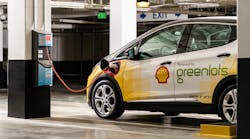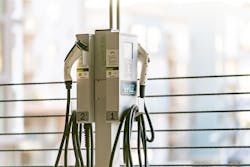One of more notable inclusions in the Biden Administration’s sweeping $2.25 trillion infrastructure bill, the American Jobs Plan, is the call to add 500,000 charging stations to power up the nation’s growing legion of battery electric vehicles (BEVs). In total, the plan proposed $174 billion in taxpayer funding toward BEVs. To put into context how important this is for the current administration, this is 28% of what was rationed for the nation’s roads, bridges, ports, and airports. And there are other parts of the massive plan that also could provide additional funds.
As proposed, the national network of charging stations would hit its goal of half a million by 2030. Both the government and private companies aided by grants and incentives would carry the construction and installation burden.
Because charging stations are an integral part to the overall plan to roll out BEVs for the consumer and commercial sectors, FleetOwner wanted to know how this funding, if passed through the House and Senate, would impact electrification. So, we asked Andreas Lips , the CEO of Greenlots, Shell’s business dealing with charging infrastructure and software.
FleetOwner: What do you think of the $174 billion for EV proliferation and the plan to build 500,000 charging stations in general? What do you think the country would look like in 2030 if this were to pass?
Andreas Lips: President Biden’s proposal comes at a perfect time – the U.S. is primed and in need for EV charging network expansion. There have been many verbal commitments by government and business leaders around electric mobility as a means to reduce emissions and support good-paying jobs. Government funding to increase accessibility and incentivize businesses and consumers to transition to EV’s will increase affordability, ease of adoption, and overall trust in the EV charging infrastructure.
If the plan were to pass, I predict that by 2030 we will see many more municipalities and governments, many more commercial fleet companies and many more consumers in EVs on U.S. roads. We will see early adopters expand and/or optimize EV and charging operations, helping to influence late adopters. The overall charging infrastructure will grow and start to bloom in charging deserts. This, along with continuously improving EV technology in market, will diminish range anxiety.
For businesses, cities and governments looking to make the EV transition, the process for vetting and installing an EV charging station requires a significant amount of investment and planning – and therefore time. I can see this timeframe getting quicker and the process easier by 2030.
There’s so much opportunity to continue to build with the right resources in place. This is why it’s the right time for government investment, which will put those that are leading the charge in a position to achieve higher charging station reliability and tech optimization, while encouraging others to adopt.
FO: What parts of the American Jobs Plan do you believe will most directly benefit electrification stakeholders?
AL: I am hopeful that the $174 billion earmarked for EVs, infrastructure, grants and incentives, and the $100 billion for power grid and clean energy development will invigorate the pace of electric transformation. This stands to supplement resources for all electrification stakeholders – OEMs, fleets, municipalities, and consumers included.
Our team is encouraged that federal dollars are being budgeted toward repair and upkeep of the current EV charging infrastructure. As roaming agreements are made across charging networks, a more operable and reliable infrastructure in the early stages of the next wave of development will be critical to influencing, and solidifying consumer and commercial adoption.
At Greenlots, we believe in a collaborative approach to electrification between automakers, utilities, cities, fleets and charging networking providers — when one stakeholder benefits, it moves the industry forward and we all get closer to a cleaner, electrified future.
FO: The electric vehicle sector has grown in the last few years, but how would you categorize the rate at which charging infrastructure has kept pace with vehicle sales/deployments?
AL: While the global charging infrastructure is close to keeping pace with EV sales and deployment, more charging stations are needed, not only to keep pace, but to continue to influence adoption — especially if the global fleet is expected to grow by more than 107 million EVs by 2030.
But simply adding more EV chargers doesn’t mean better charging experiences for EV drivers. An increase in public chargers can improve accessibility, but other factors, such as charge speed, reliability, maintenance and equal access, will also be critical. A more expansive EV charging infrastructure that is easy to access and use is critical to reaching a future of zero emissions.
FO: In terms of active Greenlots charging installations, what has been the percentage of growth specially for the last three years? What do you expect for the next few years, and will there be an inflection point soon?
AL: In 2020, Greenlots installed over 40% more charging stations than in 2019, despite the challenges of the COVID-19 pandemic. As we continue to see major commitments from fleet operators to convert to EVs and automakers to expand their EV offerings, as well as increased federal funding for EVs and charging infrastructure, we expect EV charging solutions to continue to be in demand.
Our parent company, Shell is planning to increase its number of charging stations globally to 500,000 (up from 60,000 currently) by 2025, and Greenlots will play a major role in this expansion.
I also expect expansion to continue diversifying, with EV charging reaching more families in multi-unit housing, working directly with local governments and municipalities to electrify fleet vehicles, collaborating with OEMs to integrate charging networks and more.
FO: Do you have confidence utilities will be able to work with companies such as Greenlots and fleets to prepare the grid? Is there concern about doing too much, too fast?
AL: Collaboration with utilities, business partners and customers through this transition is critical. We’ve successfully worked with utilities for many years to bring operators the tools needed to safely integrate EVs and renewables into the grid, and I am confident those partnerships will continue.
EV charging technology continues to advance, and new solutions are introduced to help limit the impact on the grid. Greenlots software and energy management offerings are designed to support EV charging installation, even when electrical capacity is limited, to reduce strain on the grid and preserve grid resources, battery storage and renewable integration.
Grid updates should still happen congruently with vehicle electrification to ensure a cleaner future overall and a more reliable grid. However, energy management charging technology will play an important role in preserving the grid as vehicle electrification becomes widespread.
President Biden’s plan is critical to the progression of electric mobility, but we anticipate that consumer and commercial adoption will continue to significantly influence the rate of transition to universal electric mobility.
FO: What can fleets do right now to understand if they would benefit from electrifying?
AL: There is no longer a question that fleets benefit from electrification. It is now a matter of how, and how fast, fleets will electrify.
As EV charging infrastructure expands, businesses can now expect the same level of reliability of ICE [internal combustion engine] fleets with no emissions, helping meet emissions targets that many large companies and governments have. Given there isn’t a one-size fits all solution for fleet customers, we suggest fleets work with their electrification partners to understand their business drivers and use case, duty cycles and main concerns, to build a solution that meets their need and provides business value.
We also encourage our fleet customers to initiate conversations with the electric utilities that serve their facilities early on in the process. Fleet electrification works best when the fleet operator and electric utility are working collaboratively to meet the fleet’s power needs efficiently and effectively.
At Greenlots, we work with our customers to outline what electrification can do for them on a multiyear basis. We know at this point that the ROI will be there; it’s a question of how fast, not if.
We support customers who want to start small and grow their electrification effort over time as more use cases become economically attractive, as well as those who want to go big from the start.
We offer turnkey solutions that help to efficiently deploy and manage EV charging infrastructure at scale, including navigating incentives. Greenlots’ policy and market development teams are incentive experts and have helped many of our customers – fleets and otherwise – identify and leverage grant and incentive funding. If the plan is passed, we’re ready to support companies and fleets take advantage of the funding that will be available.






